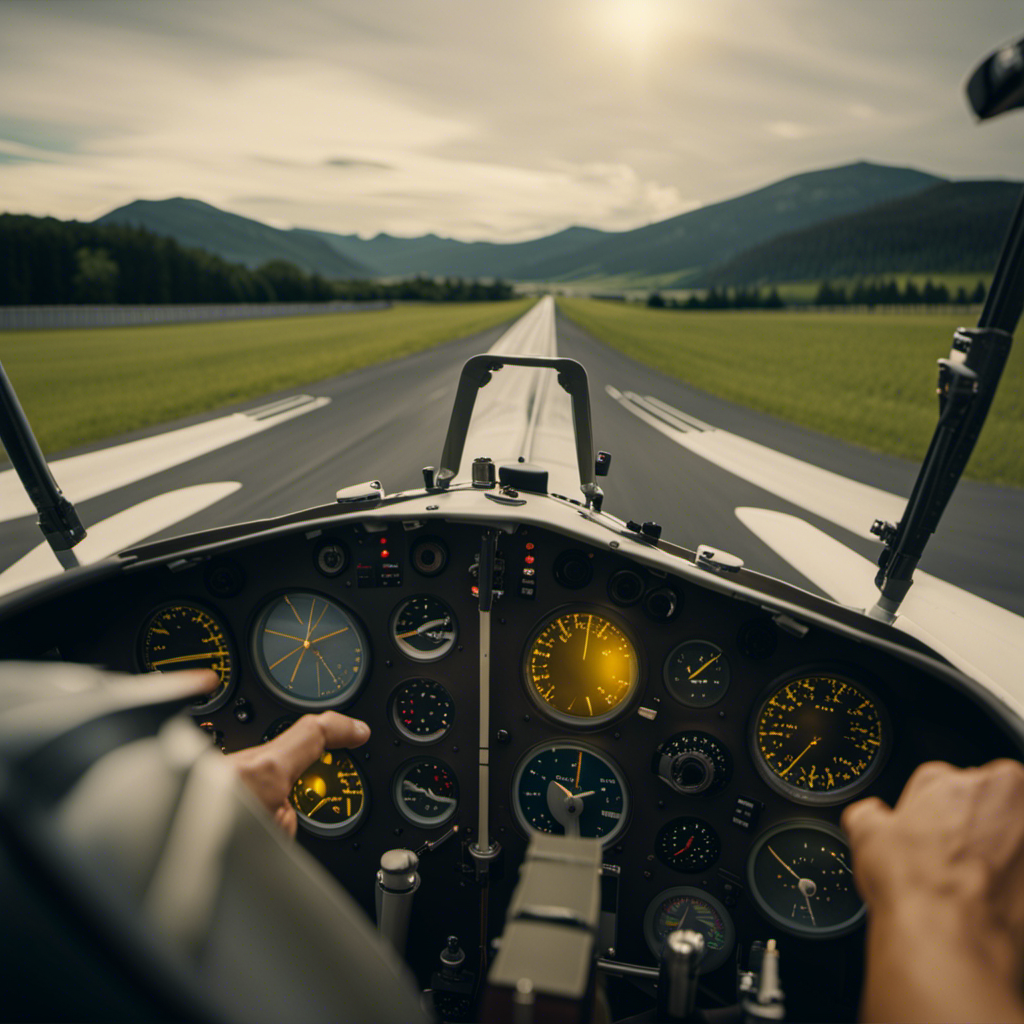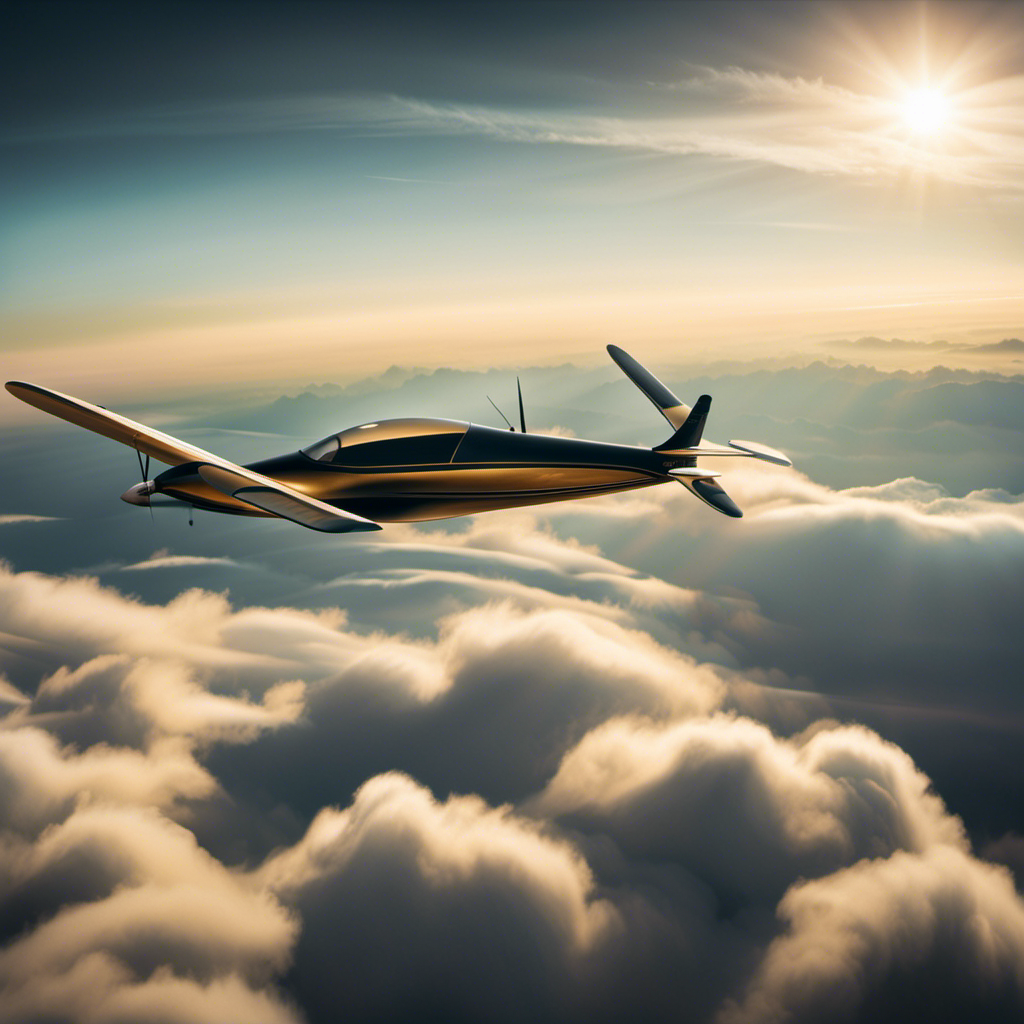As a person who is profoundly intrigued by nature, I am often amazed by the graceful manner in which birds glide through the sky. Their effortless skill of gliding through the skies, propelled by invisible air currents, is truly mesmerizing.
But behind this enchanting spectacle lies a fascinating realm of physics. In this article, we will delve into the intricate mechanisms that power the flight of these magnificent creatures.
By understanding the principles of lift, drag, and the art of harnessing air currents, we will uncover the secrets behind the soaring abilities of these avian marvels.
Key Takeaways
- Soaring birds utilize air currents and thermal updrafts to stay aloft without flapping their wings.
- The shape of their wings creates a pressure difference that generates lift, allowing them to stay airborne.
- Understanding thermal dynamics and wind patterns is essential for effectively utilizing air currents and optimizing flight efficiency.
- Soaring birds have long, narrow wings with reduced drag and increased lift, enabling them to cover vast distances with minimal effort.
Overview of Soaring Birds and their Flight Abilities
Soaring birds, like the albatross and the vulture, can effortlessly glide through the air using their large wings and specialized flight abilities. These birds have evolved to take advantage of the air currents and thermal updrafts, allowing them to stay aloft for extended periods without flapping their wings. One of the key factors that enable these birds to soar is their understanding of flight patterns and aerodynamic efficiency.
Flight patterns refer to the specific routes and paths that birds take while flying. Soaring birds have a remarkable ability to navigate through the air, utilizing the wind currents to their advantage. By studying these flight patterns, scientists have gained insights into the strategies used by these birds to optimize their flight efficiency.
Aerodynamic efficiency is another crucial aspect of soaring birds’ flight. Their wings are designed to minimize drag and maximize lift, allowing them to stay airborne for extended periods with minimal effort. The shape and structure of their wings, along with their ability to adjust wing angles, contribute to their exceptional aerodynamic performance.
Understanding the principles of lift and drag is essential for comprehending the mechanics behind soaring birds’ flight. By analyzing how these birds exploit the forces of lift and minimize the effects of drag, researchers can gain a deeper understanding of the physics that power their flight.
Transitioning into the subsequent section about understanding the principles of lift and drag, it becomes evident that studying these forces is crucial for unraveling the mysteries of soaring bird flight.
Understanding the Principles of Lift and Drag
Understanding the principles of lift and drag is crucial for comprehending how birds are able to stay airborne. Lift and drag are fundamental concepts in aviation and play a significant role in the principles of aerodynamics and flight mechanics.
Lift is the force that opposes gravity and allows an object, such as a bird, to stay aloft. It is generated by the shape of the bird’s wings and the flow of air over them. The curved shape of the wings, known as an airfoil, creates a pressure difference between the upper and lower surfaces. This pressure difference generates lift and enables the bird to overcome its weight.
Drag, on the other hand, is the resistance encountered by the bird as it moves through the air. It is caused by the friction between the bird’s body and the air molecules. The shape and surface texture of the bird, along with its speed and angle of attack, determine the amount of drag it experiences. Minimizing drag is essential for birds to achieve efficient flight and conserve energy.
By understanding the principles of lift and drag, we can appreciate the amazing adaptations and flight capabilities of soaring birds. These birds have evolved to harness air currents and utilize them to their advantage. Soaring involves exploiting rising air masses, such as thermals and updrafts, to gain altitude without flapping their wings. This technique allows them to cover vast distances with minimal effort.
The art of soaring is a testament to the remarkable abilities of these birds to navigate and thrive in their aerial environment.
Harnessing Air Currents: The Art of Soaring
As a soaring pilot, I have learned the importance of utilizing thermals and updrafts to maintain altitude and extend my flight time.
Thermals, which are columns of warm rising air, can provide a significant lift force that allows me to climb higher in the sky.
Additionally, I have also mastered the technique of riding on ridge lift and slope lift, which occur when the wind encounters a hill or mountain and is forced upward, creating a lift force that I can take advantage of.
Understanding and effectively using these air currents is crucial in the art of soaring and maximizing the potential for a successful flight.
Utilizing thermals and updrafts
You can easily take advantage of thermals and updrafts to enhance your flight. These natural phenomena play a crucial role in the flight of soaring birds, allowing them to stay aloft for extended periods of time with minimal energy expenditure. Understanding thermal dynamics and wind patterns is essential for effectively utilizing these air currents.
Here are three key points to consider:
-
Thermals: These are pockets of warm air that rise from the surface due to variations in temperature. By locating and circling within thermals, birds can gain altitude and maintain their height without flapping their wings.
-
Updrafts: Updrafts are created when wind encounters obstacles such as hills or cliffs. These rising air currents can provide additional lift and allow birds to soar effortlessly along the terrain.
-
Wind Patterns: Birds can strategically position themselves in areas where wind converges, such as ridges or valleys, to benefit from the uplift created by the wind’s flow.
By understanding the intricacies of thermal dynamics and wind patterns, birds can optimize their flight and conserve energy.
Now, let’s explore the next section on riding on ridge lift and slope lift.
Riding on ridge lift and slope lift
Riding on ridge lift and slope lift is a technique that allows pilots to utilize the upward air currents created by the interaction of wind with hills or cliffs.
Ridge soaring involves flying parallel to a ridge or mountain slope, where the wind is forced to rise due to the obstruction. As the wind encounters the hill, it is deflected upwards, creating a continuous upward flow of air along the slope. By positioning their wings at an angle to the wind, pilots can maintain lift and glide effortlessly along the ridge.
Similarly, slope soaring involves flying near the face of a steep slope, taking advantage of the wind as it rises and produces lift. These techniques require skilled piloting and an understanding of how wind interacts with terrain.
Transitioning into the subsequent section about wing morphology and adaptations for efficient flight, these aerial strategies demonstrate the ingenuity of birds and their ability to harness natural forces for sustained flight.
Wing Morphology and Adaptations for Efficient Flight
To understand how soaring birds achieve efficient flight, let’s take a closer look at their wing morphology and adaptations.
Wing flexibility and wing loading play crucial roles in their ability to stay aloft for extended periods. Soaring birds have long, narrow wings that allow for efficient gliding and soaring. This shape reduces drag and increases lift, enabling them to stay airborne with minimal effort.
Another key aspect of their wing design is wing flexibility. The wings of soaring birds are highly flexible, allowing them to adjust their shape and angle of attack in response to changing air currents. This flexibility enhances their maneuverability and enables them to exploit thermals and other updrafts effectively.
In addition, soaring birds have low wing loading. This means that their body weight is spread over a large wing area, resulting in reduced wing loading. As a result, they can glide at slower speeds and conserve energy.
Understanding these wing adaptations provides insight into the remarkable flight abilities of soaring birds. It also sets the stage for exploring the role of tail feathers in steering and stability, which further enhances their mastery of the skies.
The Role of Tail Feathers in Steering and Stability
When it comes to steering and stability, tail feathers are crucial for soaring birds. The structure of tail feathers plays a significant role in the aerodynamic control of these birds during flight.
The tail feathers are composed of long, stiff feathers called rectrices, which are arranged in a fan-like pattern. This arrangement allows the bird to adjust the position and angle of its tail feathers, providing precise control over its flight trajectory.
The tail feathers also contribute to the stability of soaring birds. By adjusting the position and angle of their tail feathers, birds can counteract any disturbances in flight, such as gusts of wind or sudden changes in direction. This allows them to maintain a stable flight and navigate through their environment with ease.
Furthermore, the tail feathers of soaring birds aid in energy conservation strategies during flight. By adjusting the shape and position of their tail feathers, birds can optimize their flight efficiency and minimize energy expenditure. This is particularly important for long-distance migrations or prolonged periods of soaring, where energy conservation is crucial for survival.
Overall, the tail feathers of soaring birds play a critical role in steering, stability, and energy conservation during flight. Understanding the intricate structure and function of these feathers provides valuable insights into the physics of flight and the adaptations that enable birds to soar effortlessly through the skies.
Energy Conservation Strategies during Flight
As we explored the role of tail feathers in steering and stability, it becomes evident that soaring birds have evolved remarkable adaptations for efficient flight. Now, let’s delve into the energy conservation strategies employed by these avian marvels.
When it comes to energy-saving techniques, soaring birds have mastered the art of optimizing flight efficiency. Here are some notable strategies they employ:
- Thermals: Soaring birds utilize rising columns of warm air, known as thermals, to gain altitude without expending much energy.
- Ridge Lift: By flying close to the slopes of hills or mountains, birds can take advantage of the upward wind deflected by the terrain, reducing the need for flapping.
- Dynamic Soaring: This technique involves flying in a circular path between wind gradients, gaining energy from the difference in airspeed.
- Ground Effect: When flying close to the ground or water surface, birds experience reduced drag, allowing them to maintain lift more efficiently.
By employing these energy-saving techniques, soaring birds can conserve precious energy during flight, enabling them to cover vast distances and remain airborne for extended periods.
Transitioning into the subsequent section on navigation and migration in soaring birds, let’s explore how these remarkable creatures navigate vast distances with astonishing accuracy.
Navigation and Migration in Soaring Birds
By utilizing internal compasses and celestial cues, soaring birds are able to navigate vast distances with astonishing accuracy. Migration patterns in these birds are not random; they follow specific routes year after year, returning to the same breeding grounds and wintering areas. How do they achieve such precise navigation?
One key method is celestial navigation, where birds use the position of the sun, stars, and even Earth’s magnetic field to orient themselves. They have an internal magnetic compass that helps them gauge their direction, and they can also detect polarized light patterns that change with the position of the sun. By combining these cues, they are able to maintain their course during migration.
Research has shown that birds can even compensate for changing celestial cues due to the rotation of Earth. Their internal compass adjusts to the changing positions of the sun and stars throughout the day, allowing them to stay on track. Additionally, birds may also use landmarks, such as coastlines or mountain ranges, to aid in their navigation.
Understanding the navigation abilities of soaring birds is not only fascinating but also has practical applications. By studying their migration patterns and celestial navigation, scientists can gain valuable insights into the mechanisms behind their remarkable abilities. This knowledge can be used to develop better navigation systems for humans, such as improved satellite-based navigation or autonomous vehicles.
Transitioning to the next section on the physics of landing and takeoff, the navigation abilities of soaring birds are just one aspect of their incredible flying capabilities.
The Physics of Landing and Takeoff
To achieve a smooth landing and takeoff, I must carefully adjust my wings and tail to control my speed and angle of descent. The physics of takeoff and landing in soaring flight involve a careful balance of aerodynamic forces.
During takeoff, I need to generate enough lift to overcome the force of gravity and begin my ascent. This requires a combination of wing flapping and utilizing the updrafts of air currents. By flapping my wings in a specific pattern, I can create enough lift to propel myself off the ground and into the air.
During landing, I must carefully control my descent to ensure a safe touchdown. This involves adjusting the angle of my wings and tail to control my speed and rate of descent. By increasing the angle of attack, I can increase the lift generated by my wings, which slows down my descent. Additionally, I can use my tail as a stabilizer to maintain balance and control during the landing process.
Understanding the physics of landing and takeoff is crucial for successful flight in soaring birds. By manipulating the forces of lift, gravity, and drag, I can optimize my flight performance and ensure a safe landing or takeoff. However, there are also challenges and limitations in soaring flight that need to be considered.
Challenges and Limitations in Soaring Flight
Navigating through turbulent air currents can be challenging and requires careful adjustments to maintain stability and control. Soaring birds face a multitude of challenges and limitations in their flight. One of the main challenges is the availability of suitable thermals. Thermals are columns of rising warm air that provide the necessary upward lift for soaring birds. However, these thermals are not always readily available, and birds have to rely on their ability to locate and exploit them efficiently.
In addition, the strength and duration of thermals can vary, posing further challenges for birds to maintain sustained flight.
Another limitation in soaring flight is the reliance on wind patterns. Soaring birds often use ridge lift and dynamic soaring to gain altitude and cover long distances. However, these techniques heavily depend on the presence of consistent and favorable wind patterns. In areas with inconsistent or weak winds, birds may struggle to find the necessary lift and may be forced to resort to alternative flight strategies or land.
Despite these challenges and limitations, soaring birds have evolved various adaptations to overcome them. For instance, they possess exceptional visual acuity and navigational abilities to locate thermals and wind currents. Additionally, their large wingspans and efficient aerodynamics allow them to make the most of the available lift.
Transitioning into the subsequent section about conservation and research efforts for soaring birds, it is crucial to understand the challenges and limitations faced by these birds in order to develop effective conservation strategies and further our knowledge of their unique flight abilities.
Conservation and Research Efforts for Soaring Birds
Understanding the challenges and limitations faced by soaring birds is crucial in developing effective conservation strategies and advancing our knowledge of their unique flight abilities. Conservation efforts for soaring birds are essential to protect and preserve these magnificent creatures and their habitats. Research initiatives play a vital role in identifying the factors that impact their populations and finding solutions to mitigate these threats.
Conservation efforts focus on various aspects, including habitat preservation, minimizing human disturbance, and reducing threats such as habitat loss, climate change, and pollution. By understanding the specific needs of soaring birds, conservationists can implement measures to ensure their survival. This may involve creating protected areas, implementing regulations to limit human activities in critical habitats, and promoting sustainable land management practices.
Research initiatives are crucial for informing conservation strategies. Scientists study the behavior, migration patterns, breeding habits, and ecological requirements of soaring birds to gather essential data. This information helps identify critical habitats, migration routes, and potential threats to their populations. By studying the biology and ecology of these birds, researchers can develop effective conservation plans and monitor the success of implemented measures.
Conservation and research efforts for soaring birds are collaborative endeavors involving scientists, conservation organizations, governments, and local communities. By working together, we can protect these incredible birds and ensure their continued existence for future generations to appreciate and admire.
Frequently Asked Questions
How do soaring birds navigate during migration?
Soaring birds navigate during migration using a combination of a magnetic compass and celestial navigation. They rely on the Earth’s magnetic field to determine their direction, and also use the position of the sun, stars, and moon to guide their flight.
What are the energy conservation strategies used by soaring birds during flight?
Soaring bird flight efficiency is achieved through a combination of aerodynamic adaptations and energy conservation strategies. These include utilizing thermal updrafts, optimizing wing shape and size, and employing efficient gliding techniques to minimize energy expenditure during flight.
What are some of the challenges and limitations faced by soaring birds in their flight?
Thermoregulation and wind patterns present challenges for soaring birds. Maintaining body temperature is crucial, as cold temperatures can affect flight performance. Additionally, wind patterns influence their ability to find updrafts and maintain a steady glide, impacting their overall flight efficiency.
What research efforts are currently being undertaken to conserve and study soaring birds?
Conservation efforts for soaring birds involve population monitoring through scientific research. By studying migration patterns, habitat preferences, and breeding behavior, we can better understand these birds and implement measures to protect their populations.
Is there any specific physics behind the landing and takeoff of soaring birds?
The physics principles behind the landing and takeoff of soaring birds involve the aerodynamics of their flight. Understanding the forces and dynamics involved in these processes is crucial for studying and conserving these magnificent creatures.
Conclusion
In conclusion, the flight of soaring birds is a marvel of physics. I am captivated by the graceful dance they perform in the sky as I reflect on the intricate details of their flight abilities.
The principles of lift and drag, the art of harnessing air currents, and the adaptations of their wing morphology all work together to create a seamless symphony of flight. Their effortless navigation and migration, using their tail feathers for steering and stability, is a testament to their innate intelligence.
However, we must also acknowledge the challenges and limitations they face. Conservation and research efforts are crucial to protect these magnificent creatures. Soaring birds truly embody the beauty and poetry of flight.









